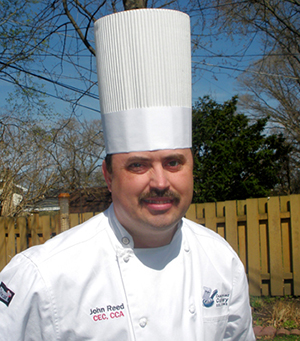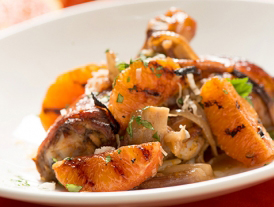Guest Speaker: The Hypocrisy of Teaching Knife Skills
 Naturally, educators must stress to their students the critical importance of proper knife skills. But, says this chef-consultant, the reality in the workplace doesn’t always match what we teach. (Don’t miss the YouTube video link.)
Naturally, educators must stress to their students the critical importance of proper knife skills. But, says this chef-consultant, the reality in the workplace doesn’t always match what we teach. (Don’t miss the YouTube video link.)
By John Reed, CEC, CCA
After addressing a group of culinary students at an ACF state competition, I sat back and thought about my words and the content.
In the skills portion of the competition, one of the four disciplines is “Knife Skills.” It requires a competitor chosen randomly from each team to perform this culinary skill. The competitors must dice an onion, cut julienne and chop some tomatoes, among other things. As judges, we critique the competitors on the accuracy of the cuts and compare them to a known standard.
One of the standards is a molded plastic form with the exact dimensions of the named cuts that are mounted to a board. I describe it as the original “3D APP.” You can look something up and then stick it back in your pocket. If you have ever been to culinary school or attended these competitions, you may have seen this guide or are at least familiar with the names of knife cuts that are common in a professional kitchen. In some cases, students spend hours fine-tuning their skills, such as lining up their little sticks of carrots in a row like little Napoleonic soldiers. A sight to see!

 Emily Williams Knight—the newest of three educators on the NRAEF’s board—is committed to helping more Americans achieve meaningful, fulfilling careers in the restaurant industry via a respected national industry platform.
Emily Williams Knight—the newest of three educators on the NRAEF’s board—is committed to helping more Americans achieve meaningful, fulfilling careers in the restaurant industry via a respected national industry platform. Familiarity with cooking and incorporating lentils into various menu applications can help your students meet nutrition regulations, budgets and consumer demands when they become foodservice professionals.
Familiarity with cooking and incorporating lentils into various menu applications can help your students meet nutrition regulations, budgets and consumer demands when they become foodservice professionals. Many students are not used to conducing structured observations and might not know what to look for and how often to record behaviors. The more explicit you are about how they should conduct the observation, the more likely it will be an effective learning experience.
Many students are not used to conducing structured observations and might not know what to look for and how often to record behaviors. The more explicit you are about how they should conduct the observation, the more likely it will be an effective learning experience. On a recent trip to Hawaii, Chef Weiner had an epiphany: Teaching our students how to cook isn’t good enough. To better prepare them for the real world, we also need to introduce students to the different formats of serving. Here are 10 effective ideas that fit nicely within a shorter class timeframe.
On a recent trip to Hawaii, Chef Weiner had an epiphany: Teaching our students how to cook isn’t good enough. To better prepare them for the real world, we also need to introduce students to the different formats of serving. Here are 10 effective ideas that fit nicely within a shorter class timeframe. As their career paths become clear, students will inevitably emulate what they’ve experienced in our classrooms and kitchens. Thus, our responsibility is great. Which attitudes, aptitudes and beliefs do we want graduates to portray throughout their careers as a result of our actions?
As their career paths become clear, students will inevitably emulate what they’ve experienced in our classrooms and kitchens. Thus, our responsibility is great. Which attitudes, aptitudes and beliefs do we want graduates to portray throughout their careers as a result of our actions? Here’s a valuable education-resources fact sheet to help educators effectively teach seafood sustainability.
Here’s a valuable education-resources fact sheet to help educators effectively teach seafood sustainability. Top chefs know that exceptional produce is where flavor begins. More produce choices equates to more chances to shine. That’s why citrus is something to celebrate.
Top chefs know that exceptional produce is where flavor begins. More produce choices equates to more chances to shine. That’s why citrus is something to celebrate.